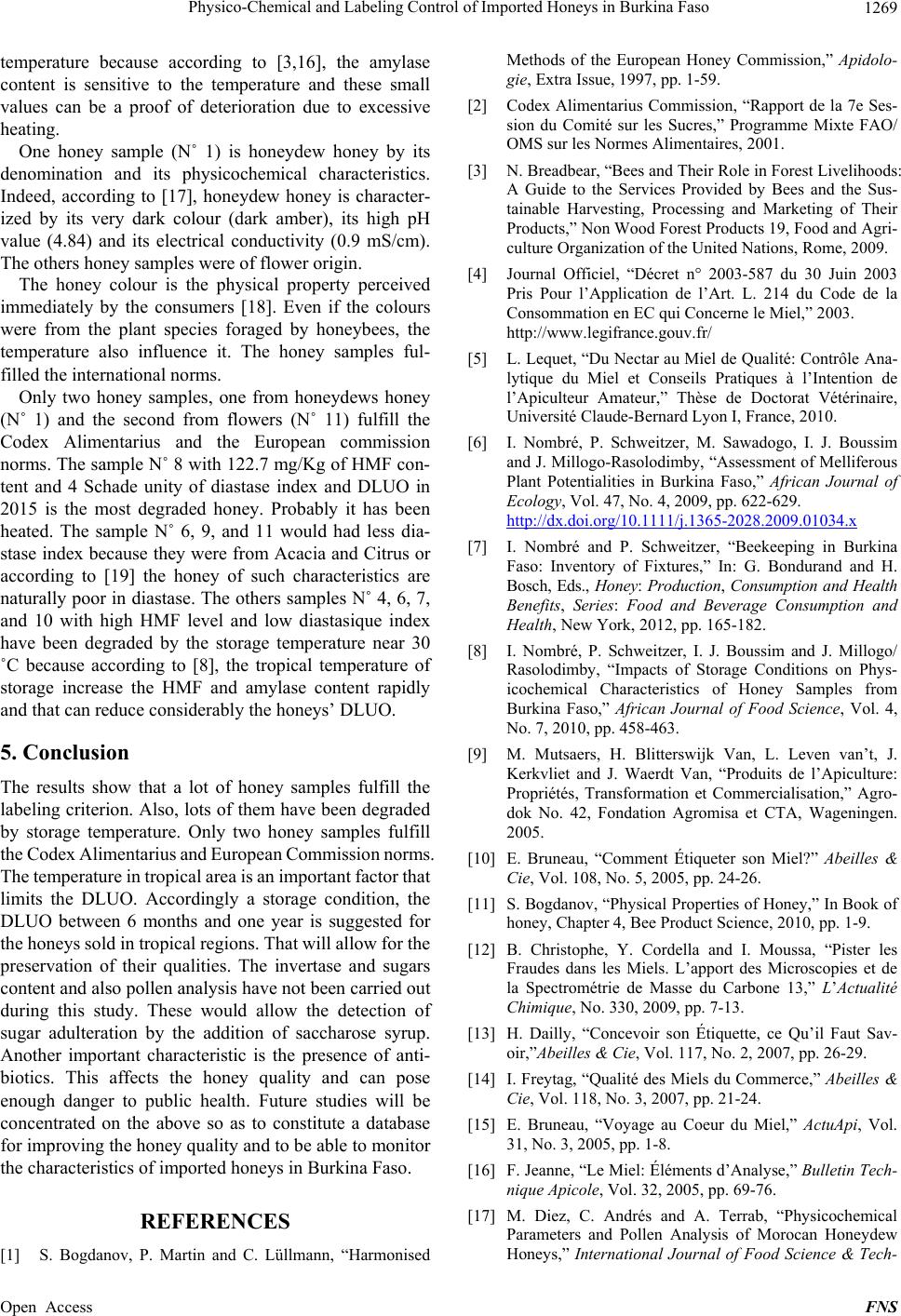
Physico-Chemical and Labeling Control of Imported Honeys in Burkina Faso 1269
temperature because according to [3,16], the amylase
content is sensitive to the temperature and these small
values can be a proof of deterioration due to excessive
heating.
One honey sample (N˚ 1) is honeydew honey by its
denomination and its physicochemical characteristics.
Indeed, according to [17], honeydew honey is character-
ized by its very dark colour (dark amber), its high pH
value (4.84) and its electrical conductivity (0.9 mS/cm).
The others honey samples were of flower origin.
The honey colour is the physical property perceived
immediately by the consumers [18]. Even if the colours
were from the plant species foraged by honeybees, the
temperature also influence it. The honey samples ful-
filled the international norms.
Only two honey samples, one from honeydews honey
(N˚ 1) and the second from flowers (N˚ 11) fulfill the
Codex Alimentarius and the European commission
norms. The sample N˚ 8 with 122.7 mg/Kg of HMF co n-
tent and 4 Schade unity of diastase index and DLUO in
2015 is the most degraded honey. Probably it has been
heated. The sample N˚ 6, 9, and 11 would had less dia-
stase index because they were from Acacia and Citrus or
according to [19] the honey of such characteristics are
naturally poor in diastase. The others samples N˚ 4, 6, 7,
and 10 with high HMF level and low diastasique index
have been degraded by the storage temperature near 30
˚C because according to [8], the tropical temperature of
storage increase the HMF and amylase content rapidly
and that can reduce considerably the honeys’ DLUO.
5. Conclusion
The results show that a lot of honey samples fulfill the
labeling criterion. Also, lots of them have been degraded
by storage temperature. Only two honey samples fulfill
the Codex Alimentarius and Eur opean Commission n orms.
The temperature in tropical area is an important factor that
limits the DLUO. Accordingly a storage condition, the
DLUO between 6 months and one year is suggested for
the honeys sold in tropical regions. That will allow for the
preservation of their qualities. The invertase and sugars
content and also pollen analysis have not been carried out
during this study. These would allow the detection of
sugar adulteration by the addition of saccharose syrup.
Another important characteristic is the presence of anti-
biotics. This affects the honey quality and can pose
enough danger to public health. Future studies will be
concentrated on the above so as to constitute a database
for improving the honey quality and to be able to monitor
the characteristics of imported honeys in Burkina Faso.
REFERENCES
[1] S. Bogdanov, P. Martin and C. Lüllmann, “Harmonised
Methods of the European Honey Commission,” Apidolo-
gie, Extra Issue, 1997, pp. 1-59.
[2] Codex Alimentarius Commission, “Rapport de la 7e Ses-
sion du Comité sur les Sucres,” Programme Mixte FAO/
OMS sur les Normes Alimentaires, 2001.
[3] N. Breadbear, “Bees and Their Role in Forest Livelihoods:
A Guide to the Services Provided by Bees and the Sus-
tainable Harvesting, Processing and Marketing of Their
Products,” Non Wood Forest Products 19, Food and Agri-
culture Organization of the United Nations, Rome, 2009.
[4] Journal Officiel, “Décret n° 2003-587 du 30 Juin 2003
Pris Pour l’Application de l’Art. L. 214 du Code de la
Consommation en EC qui Concerne le Miel,” 2003.
http://www.legifrance.gouv.fr/
[5] L. Lequet, “Du Nectar au Miel de Qualité: Contrôle Ana-
lytique du Miel et Conseils Pratiques à l’Intention de
l’Apiculteur Amateur,” Thèse de Doctorat Vétérinaire,
Université Claude-Bernard Lyon I, France, 2010.
[6] I. Nombré, P. Schweitzer, M. Sawadogo, I. J. Boussim
and J. Millogo-Rasolodimby, “Assessment of Melliferous
Plant Potentialities in Burkina Faso,” African Journal of
Ecology, Vol. 47, No. 4, 2009, pp. 622-629.
http://dx.doi.org/10.1111/j.1365-2028.2009.01034.x
[7] I. Nombré and P. Schweitzer, “Beekeeping in Burkina
Faso: Inventory of Fixtures,” In: G. Bondurand and H.
Bosch, Eds., Honey: Prod uction, Consumption and Health
Benefits, Series: Food and Beverage Consumption and
Health, New York, 2012, pp. 165-182.
[8] I. Nombré, P. Schweitzer, I. J. Boussim and J. Millogo/
Rasolodimby, “Impacts of Storage Conditions on Phys-
icochemical Characteristics of Honey Samples from
Burkina Faso,” African Journal of Food Science, Vol. 4,
No. 7, 2010, pp. 458-463.
[9] M. Mutsaers, H. Blitterswijk Van, L. Leven van’t, J.
Kerkvliet and J. Waerdt Van, “Produits de l’Apiculture:
Propriétés, Transformation et Commercialisation,” Agro-
dok No. 42, Fondation Agromisa et CTA, Wageningen.
2005.
[10] E. Bruneau, “Comment Étiqueter son Miel?” Abeilles &
Cie, Vol. 108, No. 5, 2005, pp. 24-26.
[11] S. Bogdanov, “Physical Properties of Honey,” In Book of
honey, Chapter 4, Bee Product Science, 2010, pp. 1-9.
[12] B. Christophe, Y. Cordella and I. Moussa, “Pister les
Fraudes dans les Miels. L’apport des Microscopies et de
la Spectrométrie de Masse du Carbone 13,” L’Actualité
Chimique, No. 330, 2009, pp. 7-13.
[13] H. Dailly, “Concevoir son Étiquette, ce Qu’il Faut Sav-
oir,”Abeilles & Cie, Vol. 117, No. 2, 2007, pp. 26-29.
[14] I. Freytag, “Qualité des Miels du Commerce,” Abeilles &
Cie, Vol. 118, No. 3, 2007, pp. 21-24.
[15] E. Bruneau, “Voyage au Coeur du Miel,” ActuApi, Vol.
31, No. 3, 2005, pp. 1-8.
[16] F. Jeanne, “Le Miel: Éléments d’Analyse,” Bulletin Tech-
nique Apicole, Vol. 32, 2005, pp. 69-76.
[17] M. Diez, C. Andrés and A. Terrab, “Physicochemical
Parameters and Pollen Analysis of Morocan Honeydew
Honeys,” International Journal of Food Science & Tech-
Open Access FNS